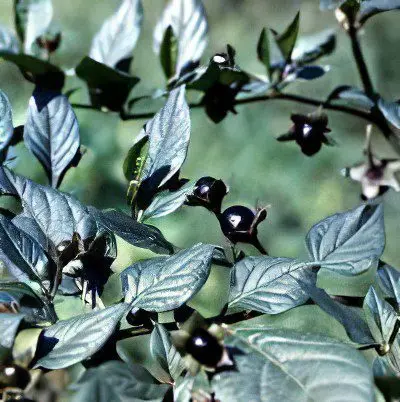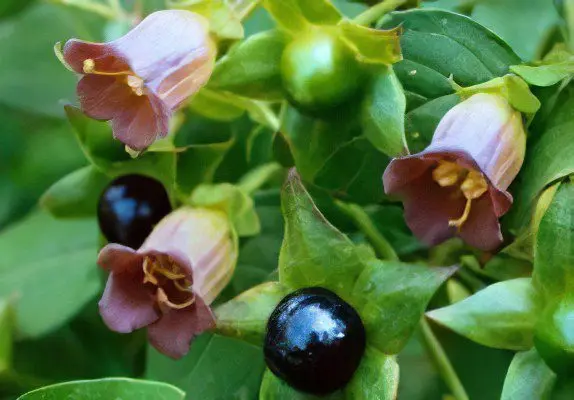Contents
Medicinal properties of belladonna and plant recipes
Belladonna is a poisonous plant

Belladonna, or belladonna as it is often called, is a perennial herbaceous plant whose height is 1-2 meters. This plant belongs to the nightshade family. Belladonna has a strong multi-headed rhizome, which resembles a cylinder with a diameter of about 8 cm. The roots of the plant are very powerful and branched. The stem of the plant is green (and sometimes with a purple tint), always straight, with many branches.
The leaves of belladonna are pointed and ovoid in shape, the color of the leaves is dark green. The lower and upper leaves differ in size. The upper leaves are arranged in pairs, but the lower ones are alternate.
Belladonna can be recognized by its flowers: they are very large (3 cm) brown-purple on the outside and dirty yellow on the inside. The fruit of belladonna is a black glossy berry that resembles an ordinary cherry in appearance. The berry consists of two nests, has many seeds. The taste of the berry is sweetish, and the juice is dark purple. Black seeds are about 2 mm long, both flat and irregular, angular or round.
The flowering of the plant depends on the year of life. For example, if the plant is in the first year of vegetation, then it blooms in August, and if it is older, then flowering begins in May and lasts until the end of the growing season. Fruit ripening occurs from July to September.
Belladonna is a plant that is very common in the mountains of the Crimea, the Caucasus and the Carpathians. But this poisonous plant also grows in Asia Minor and Central Asia, Afghanistan, South America, Pakistan and the USA.
The plant can grow both singly and in the form of thickets on the outskirts of roads, in clearings and edges in the forest. Belladonna grows in moist, humus and loose soil. Surprisingly, this poisonous and dangerous plant was listed in the Red Book of Russia.
Belladonna belongs to poisonous plants: all parts of it are poisonous, including the fruits. There have been cases when people were poisoned by honey, which was produced from belladonna pollen.
Belladonna is very dangerous for children: just two berries of this “mad cherry” lead to the death of a child. But birds do not care for this berry: thrush, starlings and other birds can peck this berry without fear.
Medicinal properties of belladonna
The whole plant contains the alkaloid hyoscyamine. Atropine is the main alkaloid of the plant, which has antispasmodic and neurogenic properties. It reduces the tone of the intestines, uterus, bronchi and other smooth muscle organs.
All the alkaloids contained in belladonna improve heart function, can dilate pupils and increase pressure inside the eye.
Application of belladonna

The leaves of the plant are used to produce tinctures, tablets, extracts and other preparations for the treatment of various diseases.
On the basis of belladonna, preparations are made that are used as an anti-inflammatory, analgesic for intestinal and stomach ulcers, for muscle pain, tuberculosis, and even for epilepsy.
In ophthalmology, atropine, which was isolated from belladonna, has been widely used. But if a person has increased eye pressure, then the use of belladonna as an eye treatment is contraindicated.
Belladonna is used for poisoning with poisonous substances or mushrooms.
Small doses of belladonna are used if they want to reduce the secretion of the salivary or sweat glands. And also a small dose of this poisonous plant normalizes the peristalsis of the pathways that remove bile and urine from the body.
Scopolamine content was found in the roots of the plant. Scopolamine is a drug used to treat Parkinson’s disease.
The juice squeezed from the leaves of the plant helps to remove age spots, if any, on any human skin area.
belladonna treatment
Belladonna tincture. This tincture is used as an anesthetic for nephrolithiasis or calculous cholecystitis. This tincture is easy to prepare. You need to take 10 grams of belladonna leaves and pour half a glass of 96% alcohol on them. Tincture should be removed in a dark place for one week to infuse. Next, do not forget to strain the remedy and take 5-10 drops for pain.
Belladonna decoction. Take 10 grams of crushed belladonna roots and fill them with one glass of boiled water. We put on fire for half an hour, after which we cool for about 10 minutes and filter. This decoction is used for pain in the joints. Compresses are made from the decoction or simply rubbed with them on problem (painful) areas of the body.
Tincture of belladonna leaves. You need to take 10 grams of belladonna leaves and insist them on 100 ml of 40% alcohol. It is necessary to take such a tincture in 5-10 drops. This medicine is used for colic, diarrhea and insomnia. And externally it is used for tumors, breast cancer and infiltrate.
Belladonna decoction. This decoction is used to treat Parkinson’s disease. You need to prepare such a remedy as follows: take 30 grams of dried and crushed plant roots and mix them with 100 grams of activated charcoal. Pour all this into 750 ml of dry white wine and put on fire. Cook for 10 minutes and remove from heat. Ready broth must be filtered. Take this brew 3 times daily before meals. Treatment lasts 3 days. A single dose of taking the medicine is 1 teaspoon. When 3 hours have passed after taking the decoction, you need to take nutmeg (on the tip of a knife). Or you can just chew a little calamus root.
Belladonna poisoning and first aid for it
Belladonna is a poisonous plant. Therefore, it is necessary to take drugs from it carefully and only under the supervision of a doctor.
Belladonna poisoning is a consequence after eating the berries of this plant (which is most often done by kids). When belladonna is harvested on plantations, it is toxic to the human body due to the fact that it is touched by hands, and then touched by them on the face.
Symptoms of belladonna poisoning are as follows: dryness is observed in the oral and nasal cavities, the pupils are dilated, vision is impaired, the face turns red. A rash is visible on the body. A person poisoned with belladonna suffers from headaches, hallucinations, it is difficult to swallow, his voice is hoarse, and vomiting and diarrhea also occur.
First aid for belladonna poisoning.Of course, the very first and most important decision is to call an ambulance! While the doctor arrives at the injured person, he needs to do a gastric lavage. To do this, make the victim drink 250–1250 ml of a solution of weak potassium permanganate or simple weak tea. Poisonous alkaloids are bound by tannin, which is contained in tea and potassium permanganate, which does not allow alkaloids to be further absorbed into the stomach. After that, a person poisoned by belladonna should start vomiting – this is normal! After taking potassium permanganate, you need to do the following: take 20-30 tablets of activated charcoal, crush them and pour 200 ml of cold water. We stir it all and give it to the poisoned person to drink.
If necessary, you can wash the stomach again, but not earlier than after the first wash, 1-2 hours will pass.
In the event of a strong heartbeat or in the presence of shortness of breath, heart drops should be given to the victim.
If the heart suddenly stops and the person stops breathing, then resuscitation measures should be taken immediately.
Even if the victim feels better, he still needs to go to the hospital.
In order not to be poisoned by this plant, you need to follow the dosage and take preparations from belladonna very carefully!









